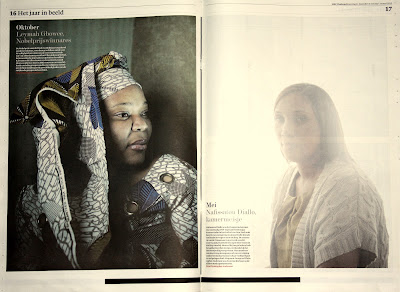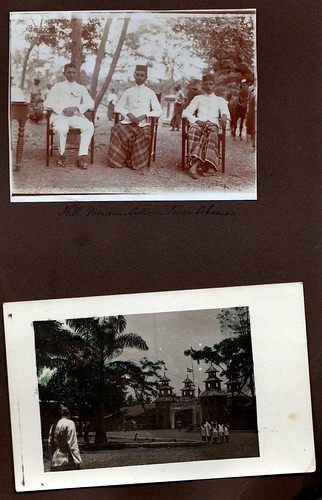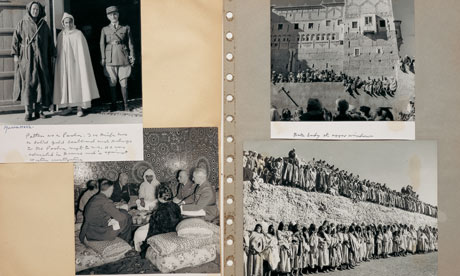2011 in beeld
Geen gewoon jaaroverzicht, maar een bloemlezing uit de collectie van 's werelds bekendste fotoagentschap, Magnum. NRC Weekend mocht een selectie maken van het werk van Magnum-fotografen uit 2011. Het jaar van Fukushima, van het kamermeisje en DSK, van William en Kate. En vooral: het jaar van de demonstrant.
Op dit artikel rust auteursrecht van NRC Handelsblad BV, respectievelijk van de oorspronkelijke auteur.
Chris Steele-Perkins
De wereld vanuit de breedhoek
Evert Hermans, Chef fotoredactie NRC Handelsblad
Er bestaat geen vergeten continent. Iedereen is fotogeniek.
De fotografen van agentschap Magnum zijn aanwezig bij het nieuws, maar ze hebben ook oog voor de kleine dingen. Er is grote liefde voor verdieping, maar evenveel aandacht voor het alledaagse. Van schooljeugd in Medellín tot grote conflicten in het Midden-Oosten. Rebellie en honger, maar ook huppelende kinderen en hoogbejaarde fotomodellen. Foto's van een verdwaalde toerist maar ook van grimmige wereldleiders. Geluk en verdriet, vaak op één en hetzelfde fotorolletje (en tegenwoordig misschien nog wel vaker op de geheugenkaart). Het agentschap fotografeert de wereld met een grote breedhoek.
De fotografen van Magnum stonden dit jaar vooraan om te kijken naar de Arabische lente, ze waren bij de hongersnood in Afrika maar ook op de mondaine skipistes van Sankt Moritz en (zoals op deze pagina's) prettoeristen in de Gobi-woestijn. Magnumfotografen richten hun lens op het leven.
Dat is eigenlijk net als de redacteuren van NRC Handelsblad, alleen hebben wij geen kantoor in Parijs, hartje Montmartre, in de schaduw van de Sacre-Coeur. Kronkelende straatjes brengen je tot aan de hoek van de rue Hégésippe Moreau en rue Ganneron. Het geurt er naar croissants en espresso. Een verdwaalde toerist passeert, op zoek naar de basiliek. Het voelt als wandelen door een oud fotoboek. In een uit rode baksteen opgetrokken pand, achter een metalen poort, huist het agentschap. Een cijfercode opent deze kluis van herinneringen, fotogetuigenissen in zwart-wit en kleur.
Dit is het grote fotoalbum van de naoorlogse wereld. De honderden boeken tegen de wand zijn de spiegel van ons leven. Hier wordt de wereld bewaard en bewaakt. In de lade van het jaar 2011 zit veel kommer, maar ook uitgelaten momenten. Ellende conflicten en heldendom.
De redactie van NRC Handelsblad biedt met plezier en trots de allerbeste foto's van het afgelopen jaar aan. Dit is niet zomaar een nieuwsjaaroverzicht; de lezer zal vergeefs zoeken naar grote nieuwsevenementen als de moordpartij van Anders Breivik in Noorwegen of nationale gebeurtenissen als de zaak van de Angolese jongen Mauro en de ruimtereis van André Kuipers. Deze pagina's zijn niet meer en niet minder dan een bloemlezing uit de donkere kamers vanMagnum 2011. Wij wensen de lezers veel kijkplezier.
Het agentschap Magnum is in 1947 opgericht door fotografen als Robert Capa en Henri Cartier-Bresson. Het idee was een agentschap te stichten als coöperatie van de aangesloten fotografen. En dat idee heeft tot de dag van vandaag standgehouden. In de 64 jaar van zijn bestaan sloten zich zeer uiteenlopende fotografen aan, zoals W. Eugene Smith, Raymond Depardon, Sebastião Salgado, Martin Parr, Carl De Keyzer. Gedragen door hun talent groeide Magnum uit tot het meest prestigieuze fotoagentschap ter wereld. Vanuit de vier kantoren die Magnum heeft - in New York, Parijs, Londen en Tokio - en een netwerk van agenten levert het bureau foto's aan pers, galerieën en musea. In Nederland wordt Magnum vertegenwoordigd door Hollandse Hoogte.
Info: Deze bijlage kwam tot stand met medewerking van Rosan Hollak, Eva de Valk, Maartje van Ours, Milly Lems en Clement Saccomani.
Foto-onderschrift: Chinese toeristen in een thema-pretpark in de Gobi-woestijn in Mongolië. Thema van het park: zand. Het Xiangshawang Desert Tourist Resort ligt aan de rand van de Gobi, vlak bij de stad Baotou. Aangemoedigd door het Chinese Fotografie Magazine komen toeristen hier om op quads of op kamelen door het mulle zand te rijden, om te vliegeren en zandkastelen te bouwen, om Mongoolse dansen en feesten te bewonderen, en vooral om van dat alles foto's te maken.
Foto-onderschrift: Chinese toeristen in een thema-pretpark in de Gobi-woestijn in Mongolië. Thema van het park: zand. Het Xiangshawang Desert Tourist Resort ligt aan de rand van de Gobi, vlak bij de stad Baotou. Aangemoedigd door het Chinese Fotografie Magazine komen toeristen hier om op quads of op kamelen door het mulle zand te rijden, om te vliegeren en zandkastelen te bouwen, om Mongoolse dansen en feesten te bewonderen, en vooral om van dat alles foto's te maken.
Op dit artikel rust auteursrecht van NRC Handelsblad BV, respectievelijk van de oorspronkelijke auteur.
Dominic Nahr
Martin Parr
Dominic Nahr
Thomas Dworzak
Dominic Nahr
Tim Hetherington
April De laatste foto's van Tim Hetherington
Een getalenteerd fotograaf, een bijzonder mens. Fotograaf Christopher Anderson, buurman van Tim Hetherington in New York, struikelt over zijn woorden als hij iets wil zeggen over de dood van zijn collega. Ik heb vooral een goede vriend verloren.
Op 20 april werd de Brits-Amerikaanse fotograaf samen met zijn collega Chris Hondros gedood bij een mortieraanslag in Libië. Anderson kreeg de spullen van de overleden fotograaf toegestuurd en zag als eerste de laatste beelden die zijn vriend maakte in de buurt van Misrata en Ajdabiya. Over die opnamen heeft Anderson zoveel mogelijk informatie verzameld van journalisten en fotografen die met Hetherington in Libië op pad waren.
Rond 11 april fotografeerde Hetherington in en rond Ajdabiya, vanaf 18 april was hij in de buurt van Misrata. Het beeld van het lijk in het mortuarium maakte Hetherington vermoedelijk in Misrata. Op de laatste foto die hij maakte, staat een Libische legerhelm met een kogelgat. Dat was luttele minuten voordat hij bij een mortieraanval om het leven kwam. Ook een zelfportret voor de spiegel zat bij de laatste beelden. Op verzoek van de nabestaanden heeft Anderson het archief bij fotoagentschap Magnum ondergebracht. Voor zijn overlijden was Tim daar al mee bezig. Ik vind het een troostende gedachte dat zijn wens in vervulling is gegaan. Foto's Tim Hetherington
Op dit artikel rust auteursrecht van NRC Handelsblad BV, respectievelijk van de oorspronkelijke auteur.
Christopher Anderson
Mei Nafissatou Diallo, kamermeisje
Nafissatou Diallo was het kamermeisje met wie voormalig IMF-topman Dominique Strauss-Kahn in het Sofitel van New York seks had. De van oorsprong Guinese Diallo diende een klacht in wegens aanranding. De arrestatie van de Fransman in mei werd wereldnieuws, zijn presidentiële aspiraties waren in één klap voorbij. Hoewel hij toegaf seks te hebben gehad met het meisje, ontkende hij dat het onvrijwillig was geweest. Het openbaar ministerie zag in augustus af van vervolging omdat het kamermeisje in haar verklaringen te veel gelogen had. Magnum-fotograaf Christopher Anderson was de eerste die haar na de affaire mocht portretteren.Foto Christopher Anderson
Op dit artikel rust auteursrecht van NRC Handelsblad BV, respectievelijk van de oorspronkelijke auteur.
Christopher Anderson
Christopher Anderson
April Walsall
Inwoners van Westbourne Street in het Walsall bekijken de bruiloft van William Windsor en Kate Middleton. Op 29 april trouwde de Britse kroonprins met zijn bruid en 28,4 miljoen landgenoten keken mee. Het koninklijk huwelijk was tevoren aangekondigd als een mega-evenement. Er werd voorspeld dat 2 miljard mensen wereldwijd de plechtigheid op televisie zouden bijwonen - in Nederland viel dat wel mee: 2,2 miljoen kijkers. In de dagen ervoor en erna werden souvenirs als koffiemokken en theeservies bij vele duizenden verkocht. Foto's Martin Parr
Op dit artikel rust auteursrecht van NRC Handelsblad BV, respectievelijk van de oorspronkelijke auteur.
2012 Narcissus
Fotograaf Stuart Franklin heeft zich voor deze serie afgezonderd op het eiland Øtroya in Noorwegen. Ik heb geprobeerd te kijken naar wat ik om mij heen zag. Écht kijken, naar één plek, en die plek net zo lang op mij laten inwerken tot ik er een relatie mee kreeg. Telkens ontdekte ik nieuwe dingen. Ik ben intuïtief te werk gegaan, ik heb geprobeerd een emotionele band met de omgeving op te bouwen. De foto's gaan over de relatie van mensen met hun omgeving, de psyche van het landschap.
Ik sta in de traditie van het landschapsgenre, maar ik heb mij ervan geprobeerd los te maken. Dat is de basis van goede kunst: het moet ruimte openlaten, dubbelzinnigheid toestaan. Dat heb ik ontdekt op Øtroya : hoe meer je ontspant, des te gemakkelijker het is om ruimte open te laten.
Exposities van Stuart Franklin vinden plaats in 2012 in museum lesund in Noorwegen en in de galerie van Magnum in Parijs. Het boek Narcissus komt uit in de herfst van 2012 in een Engelse en Noorse editie. Foto Stuart Franklin
Op dit artikel rust auteursrecht van NRC Handelsblad BV, respectievelijk van de oorspronkelijke auteur.











































